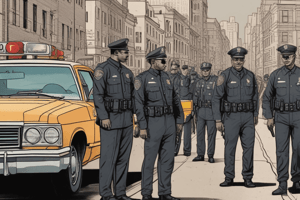Podcast
Questions and Answers
What is one impact of hate or bias crimes on the victim group?
What is one impact of hate or bias crimes on the victim group?
- Enhanced social connections among group members
- Heightened isolation and vulnerability (correct)
- Improved emotional resilience among members
- Increased integration within the community
Which statement reflects the Toronto Police Service's approach to hate/bias crimes?
Which statement reflects the Toronto Police Service's approach to hate/bias crimes?
- Law enforcement is the sole focus in response to hate crimes.
- Community engagement is secondary to legal enforcement.
- Victim support is not prioritized in investigations.
- There is a strong message of respect for a diverse society. (correct)
Who is responsible for investigating hate/bias crimes within the divisional structure?
Who is responsible for investigating hate/bias crimes within the divisional structure?
- Community Outreach Teams
- Intelligence Services – Hate Crime
- Local Patrol Officers
- Divisional Detective Office (correct)
What action is mandatory for supervisory officers upon notification of a hate/bias crime?
What action is mandatory for supervisory officers upon notification of a hate/bias crime?
What role does Intelligence Services – Hate Crime play in hate crime investigations?
What role does Intelligence Services – Hate Crime play in hate crime investigations?
Which of the following best describes the commitment of the Toronto Police Service?
Which of the following best describes the commitment of the Toronto Police Service?
How should hate/bias crimes and hate propaganda be reported according to the procedure?
How should hate/bias crimes and hate propaganda be reported according to the procedure?
What is one of the first actions required when dispatched to the scene of a hate/bias crime?
What is one of the first actions required when dispatched to the scene of a hate/bias crime?
Which criterion is NOT considered when determining if an incident is classified as a hate/bias crime?
Which criterion is NOT considered when determining if an incident is classified as a hate/bias crime?
What should be included in the applicable eReports following a hate/bias crime incident?
What should be included in the applicable eReports following a hate/bias crime incident?
What action should be taken if graffiti is found at the scene of a hate/bias crime?
What action should be taken if graffiti is found at the scene of a hate/bias crime?
What must be marked at the top of the eReport when a suspect is arrested for a hate/bias crime?
What must be marked at the top of the eReport when a suspect is arrested for a hate/bias crime?
When dealing with an incident motivated by hate that reveals no apparent offence, what is an appropriate action?
When dealing with an incident motivated by hate that reveals no apparent offence, what is an appropriate action?
What factor is essential for assessing threats to safety at the scene of a hate/bias crime?
What factor is essential for assessing threats to safety at the scene of a hate/bias crime?
What should be the primary focus when handling a hate crime incident?
What should be the primary focus when handling a hate crime incident?
What responsibility does the local government agency have regarding graffiti removal from public property?
What responsibility does the local government agency have regarding graffiti removal from public property?
What must be ensured regarding evidence in a hate/bias crime investigation?
What must be ensured regarding evidence in a hate/bias crime investigation?
When an officer determines a call is not a hate/bias crime, what is the next step they must take?
When an officer determines a call is not a hate/bias crime, what is the next step they must take?
If a hate/bias crime involves firearms, what is a key requirement for investigation?
If a hate/bias crime involves firearms, what is a key requirement for investigation?
What is required from the Officer in Charge upon being notified of a hate/bias crime?
What is required from the Officer in Charge upon being notified of a hate/bias crime?
What should happen if a charge is supported in a hate/bias crime case?
What should happen if a charge is supported in a hate/bias crime case?
What action should a Detective Sergeant take if further investigation is not warranted?
What action should a Detective Sergeant take if further investigation is not warranted?
What is one responsibility of the Divisional Hate Crime Coordinator?
What is one responsibility of the Divisional Hate Crime Coordinator?
In cases involving stalking or threatening behavior where there is serious potential for violence, what should be done?
In cases involving stalking or threatening behavior where there is serious potential for violence, what should be done?
What should occur if a hate/bias crime incident results in an arrest?
What should occur if a hate/bias crime incident results in an arrest?
Flashcards are hidden until you start studying
Study Notes
Impact and Rationale
- Hate or bias crimes extend beyond individual victims, affecting entire communities and resulting in increased fear and vulnerability.
- Unchecked hate crimes can escalate social tensions and damage community cohesion.
- The Toronto Police Service emphasizes respect for diversity and commitment to protect all individuals.
Supervision and Notification
- Mandatory notification and attendance are required from Supervisory Officers and Divisional Detective Sergeants for hate/bias crime incidents.
- Intelligence Services – Hate Crime must be notified whenever a hate/bias crime or hate propaganda is reported.
Reporting and Investigation Procedures
- Hate/bias crimes and hate propaganda are reported as separate offenses.
- Police officers respond to all hate/bias crime reports, ensuring thorough investigation and appropriate community education.
- The divisional detective office is responsible for investigating hate/bias crimes with support from Intelligence Services – Hate Crime.
Officer Response Responsibilities
- Police officers must assess the scene, secure evidence, and ensure victim assistance including medical aid and Victim Services support.
- A thorough initial investigation is crucial; officers should document all relevant details, including motives, victim and suspect relationships, and any cultural considerations.
Determining Hate/Bias Crime
- Factors for determining a hate/bias crime include:
- Suspect's motive or lack thereof.
- Victim's and community's perception of the crime.
- Presence of hate symbols or literature.
- Timing of incidents related to significant dates for victim or suspect.
Arrest Protocols
- Upon arrest for hate/bias crimes, officers must document the nature of the crime clearly in reports and ensure victims are informed about support services.
Evidence Preservation and Reporting
- Officers must preserve any evidence even in incidents where no apparent crime has occurred, ensuring that all actions are documented appropriately in the eReports.
Supervisory and Command Responsibilities
- Supervisory officers must ensure thorough, quality responses are delivered and coordinate attendance of necessary investigative units.
- Officers in charge must be notified of significant incidents, especially those involving bodily harm or property damage.
Community and Victim Support
- Victims should be assured of comprehensive investigations and community safety measures.
- Community-based agency referrals are to be made for conflict resolution.
Definitions and Legal Framework
- Hate/Bias Crime is motivated by hate or prejudice against identifiable groups based on race, religion, sexual orientation, etc.
- Hate Incident refers to non-criminal actions motivated by hate, such as derogatory remarks.
- Hate Propaganda includes communication advocating or promoting genocide or hatred against identifiable groups.
Legal Provisions
- The Criminal Code under section 718.2 enables increased sentencing for hate/bias crimes and outlines specific definitions and distinctions necessary for legal proceedings.
- Prosecution for hate propaganda requires Attorney General consent for severe cases, while public incitement of hatred does not.
Coordination with Authorities
- Intelligence Services – Hate Crime coordinates with the Attorney General’s office regarding legal proceedings for incidents deemed to be hate propaganda or hate crimes.
Studying That Suits You
Use AI to generate personalized quizzes and flashcards to suit your learning preferences.


